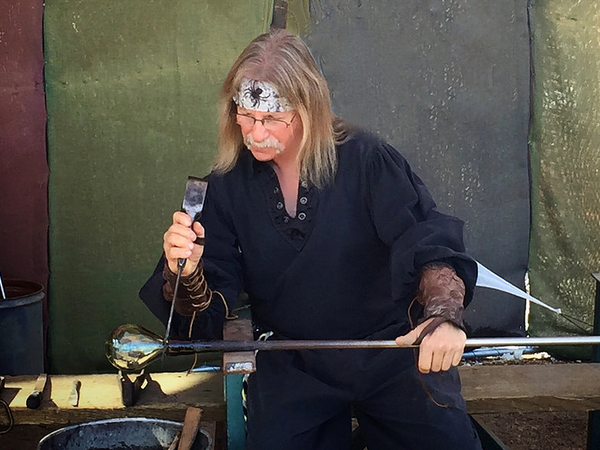Abelman Art Glass
Stuart Abelman’s artistic ability was recognized at an early age, giving him the
opportunity to study sculpture and painting as a young man. By seventeen he had quite an impressive portfolio. He was accepted to Carnegie Mellon University in Pennsylvania where he studied fine art for four years and there received his Bachelor of Fine Arts degree.
It was in his senior year at Carnegie Mellon University that he first saw the brand new glass department. It was love at first sight. He devoted his entire senior year to glassblowing. Stuart then entered the graduate four-year Master of Fine Arts program at U.C.L.A. and proceeded to study and blow glass for four more intensive years. During this time he was a Teaching Associate at U.C.L.A. and a partner in a small two man glassblowing studio that he helped build in Inglewood California. Stuart received his Master of Fine Arts from U.C.L.A. in 1976. By this time he had already created a body of work that was finding its way into art shows and galleries.
While at U.C.L.A., El Camino College called to ask if he would run their glassblowing department. He did this as well as teaching a ceramics class and developing a flat glass program for them.
After several years as a college instructor, Stuart realized that although he loved teaching, he did not have the time to create in glass all of the ideas he found himself constantly sketching. Stuart had always drawn and doodled on any available scrap of paper, even asa very young child. As he grew older this even included drawing borders on his collegeexam papers, but now he found himself drawing ideas for glass on paper napkins in restaurants and on airplane flights. It was time to start his own studio, so in 1976 Stuartleft teaching and started Abelman Art Glass.
Stuart spent much of 1976 building his studio: Furnaces, pot furnaces, glory holes (re-heating furnaces), annealing ovens, glassblower benches, etc… and in June of 1977 thefirst furnace was lit at the Abelman Art Glass studio in Southern California.
Although glassblowing was one of Colonial America’s first industries, and enjoyed great popularity during the Art Nouveau period in the late 1800’s, hand blown art glass had all but disappeared from the American art scene until the 1960’s. Stuart Abelman was oneof a select group of pioneering studio glass artists who saw the magic and challenge inglass and set about starting the Studio Art Glass Movement.
Stuart uses his own formulas and the finest silica sand to ensure the purest quality glasspossible. Each piece is made entirely of hot molten glass and is worked and completed atthe furnace. All the colors and design patterns are formed from the hot glass. No paint isused. Many of the beautiful colors are made with gold, silver and other precious metals.
Stuart’s glass pieces are shown in galleries and museums around the world and have become permanent additions to museum, private and celebrity collections here and overseas. The Kobe Museum in Japan has a piece in its collection, and his piece in the permanent collection of the Corning Museum is particularly notable for its infusion of life into a figurative sculpture in glass. Stuart Abelman was the first to bring figurative sculpture to hand blown glass in the new art glass studio movement in the United States in the late 1960’s and early 1970’s. It was a hard sell back then but has become an established form of expression in the current art glass arena. Many American StudioGlass artists now express themselves through figurative sculpture.
Abelman’s early work in figurative sculpture led to his studio production of the unicorn that was chosen for the American Express Catalog in the 1980’s. Its success allowed himto expand his artistic endeavors in this area and led to his reptile and amphibian work.During these same years Stuart wanted to find another way to breathe life into glass in away that would touch everyone, glass collector or not. The result of this desire was the series of Limited Edition Clowns that are much sought after. Nancy Bingham, anAmerican authority on Murano clowns put Stuart Abelman’s clowns into her secondbook for private Murano clown collectors because of their uniqueness, level of difficulty and artistic expression. Stuart has designed over 50 different limited edition clowns.Stuart’s Christmas ornaments are in the collection of the Smithsonian, and have gracedthe cover of the Chrysler Museum Holiday brochure, Sunset Magazine as well as the White House tree.
Stuart has journeyed through many new frontiers in the American hand blown art glass studio movement including extensive commission work for the movie, fashion, and entertainment industries. Stuart played a 300 A.D. glassblower in a PBS movie, and a glass artist at an art show in a Showtime pilot movie. Special effect shoots at Paramount Studios, the cover of a romance novel, his work chosen by the Los Angeles Olympic committee as a gift for the all around gold medal winner in gymnastics in the 1984 games, and a piece in Disney’s exclusive Club 33, are just a few of the stories that make up his life in glass.
“I have been working with hot glass for so many years that I am certain it runs through my veins.” - Stuart Abelman

Sorry, there are no products in this collection